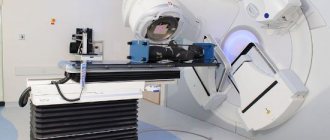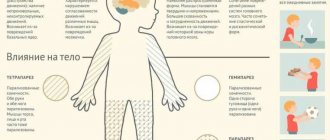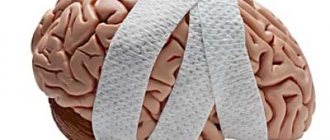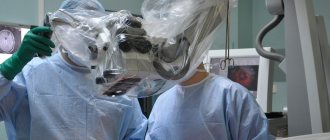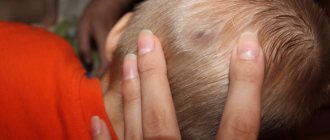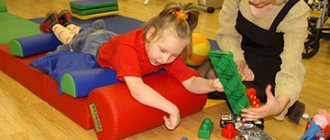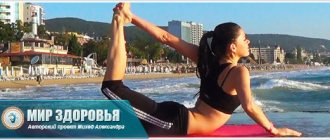Spinal cord injury (ICD 10 – S14) is an injury that is accompanied by disruption of the functions and anatomical integrity of the spine, spinal cord, spinal nerve roots, and great vessels. Damage to the spinal column and spinal cord can result from both direct traumatic effects on the spine and its indirect trauma associated with a fall from a height, road traffic accidents, forced bending due to rubble, etc.
The clinical picture depends on the severity and level of damage. Such an injury may be accompanied by transient paresis and sensory disorders or paralysis, impaired motor function, disorders of the pelvic organs, respiratory and swallowing functions.
To diagnose spinal cord injury (SCI), the leading medical center in Moscow, the Yusupov Hospital, uses spondylography, myelography, computed tomography or magnetic resonance imaging, and lumbar function. The treatment of such injuries involves repositioning, immobilization, vertebral fixation, brain decompression and subsequent rehabilitation therapy. The Spinal Cord Injury Center of the Yusupov Hospital offers services for the effective rehabilitation of patients who have suffered SCI.
Symptoms
Symptoms of spinal cord injury vary greatly depending on the type, location, and severity of the injury. A complete loss of muscle control and sensation is called a complete spinal cord injury, while a partial loss is called an incomplete spinal cord injury. Typically, the higher the location of the injury, the more severe the symptoms.
One of the most common symptoms of spinal cord injury is paralysis—the loss of motor function in a specific part of the body. In this case, there may be a complete or partial lack of sensitivity in the paralyzed area. Damage to a cervical vertebra can lead to paralysis of the arms, chest and legs, as well as the muscles that control breathing. Damage to the vertebrae in the upper or lower back can cause paralysis of the chest and legs.
Primary symptoms of spinal cord injury include:
- pain
- numbness, tingling or loss of sensation
- weakness
- dizziness
- confusion
- loss of muscle function (paralysis)
- labored breathing.
In addition to these symptoms, you may develop:
- fecal or urinary incontinence
- sexual dysfunction
- spastic state of muscles (spasms).
If you witness another person suffering a head, neck, or back injury, you should:
- call an ambulance
- do not allow the body to move (in case of injury)
- roll up a blanket or towel and secure the victim's head on both sides with it.
- if necessary, provide first aid (artificial respiration or applying a compressive bandage to the wound). Make sure your head and neck remain secure.
Spinal shock: what is it?
In this state, the brain simply turns off; the autonomous functioning of the heart and lungs helps a person maintain the body and vital functions. Previously, spinal shock was regarded in medicine as a death sentence; recovery from this condition was impossible; there were no ways or means to get out of it.
Modern medicine today has many different tools and methods for diagnosing, treating and rehabilitating spinal shock.
A detailed study of symptoms and cause-and-effect relationships makes it possible to build a clear plan of action for prompt assistance. Special electrical impulse therapy is carried out to support muscle tone, eliminating atrophy and complete immobilization. But in order to avoid worsening symptoms, such therapy is not used immediately, but only after some time.
After the spinal shock goes away, the human body is divided into two components: consciously controlled and autonomous. From this moment, rehabilitation measures and restoration of the functioning of the entire body begin.
Causes and risk factors
There are two main causes of spinal cord injury. The first is a shock effect on the spinal column. As a result of such exposure, damage occurs to the vertebrae or nearby tissues, which in turn can affect the spinal cord. Most often, this happens in car accidents, sports injuries, falls or assaults, in particular from a gunshot wound or a knife wound. After a few days, additional damage may develop. Bleeding, swelling, and fluid buildup can put pressure on the spinal cord.
Some diseases can also cause damage to the spinal cord. These include arthritis and polio. Aging and osteoporosis are risk factors because they weaken the spinal column and make it more vulnerable to injury. Spina bifida is a congenital birth defect that is similar to a spinal cord injury.
Spinal cord injury
It is necessary to immobilize the spine, carefully and quickly transport a patient with a spinal cord injury to the nearest multidisciplinary hospital, which has specialists and capabilities for treating spinal patients, or (preferably) to a specialized neurosurgical department. An unconscious patient at the place where he is found after an accident, a fall from a height, a beating and other incidents that may result in a spinal cord injury must undergo immobilization of the spine. Such a patient should be regarded as having a spinal injury until proven otherwise.
Indications for emergency surgical intervention for spinal cord injury:
- the appearance and/or increase in neurological spinal symptoms (the presence of a “light gap”), which is typical for those types of early compression that are not accompanied by spinal shock;
- blockade of the cerebrospinal fluid pathways;
- deformation of the spinal canal by X-ray negative (hematoma, traumatic intervertebral hernia, damaged ligamentum flavum) or X-ray positive (bone fragments, structures of dislocated vertebrae or due to severe angular deformation) compression substrates in the presence of corresponding spinal symptoms;
- isolated hematomyelia, especially in combination with blockade of the cerebrospinal fluid pathways;
- clinical and angiographic signs of compression of the main vessel of the spinal cord (urgent surgical intervention is indicated);
- hyperalgic and paralytic forms of spinal nerve roots;
- unstable injuries of vertebral motor segments, posing a threat to secondary or intermittent compression of the spinal cord.
Contraindications to surgical treatment of spinal cord injury:
- traumatic or hemorrhagic shock with unstable hemodynamics;
- associated injuries to internal organs (internal bleeding, risk of developing peritonitis, cardiac contusion with signs of heart failure, multiple rib injuries with hemopneumothorax and symptoms of respiratory failure);
- severe traumatic brain injury with impaired level of consciousness on the Glasgow scale less than 9 points, with suspected intracranial hematoma;
- severe concomitant diseases accompanied by anemia (less than 85 g/l), cardiovascular, hepatic and/or renal failure;
- fat embolism, pulmonary embolism, unfixed limb fractures.
Surgical treatment of spinal cord compression must be carried out in the shortest possible time, since the first 6-8 hours account for 70% of all irreversible ischemic changes that occur as a result of compression of the brain and its vessels. Therefore, existing contraindications to surgical treatment must be eliminated actively and as quickly as possible in the intensive care ward or resuscitation department. Basic therapy includes regulation of respiratory and cardiovascular functions; correction of biochemical indicators of homeostasis, fight against cerebral edema; prevention of infectious complications, hypovolemia, hypoproteinemia; regulation of the functions of the pelvic organs by installing the Monroe tidal system or catheterizing the bladder at least four times a day; correction of microcirculation disorders; normalization of rheological blood parameters; introduction of angioprotectors, antihypoxants and cytoprotectors.
For atlantooccipital dislocation, patients are advised to undergo early reposition using craniocervical traction or immediate closed reduction using the Richet-Hüter lever method. After eliminating the atlantooccipital dislocation, immobilization with a thoracocranial plaster cast and head holder is used. In cases of complicated dislocations of the cervical vertebrae, in the first 4-6 hours (before the development of cerebral edema), a one-stage closed reduction of the dislocation using the Richet-Hüther method is indicated, followed by external fixation for two months. If more than 6 hours have passed since the spinal cord injury and the patient has a syndrome of complete impairment of reflex activity of the brain, open reduction of the dislocation through the posterior approach in combination with posterior or anterior spinal fusion is indicated.
For comminuted fractures of cervical vertebral bodies and their compression fractures with an angular deformation of more than 11 degrees, anterior decompression of the brain is indicated by removing the broken vertebral bodies and replacing them with a bone graft, a cage with bone chips or a porous titanium-nickel implant in combination with or without a titanium plate. If more than two adjacent vertebrae are damaged, anterior or posterior stabilization is indicated. When the spinal cord is compressed from behind by fragments of a broken vertebral arch, posterior decompression is indicated. If the spinal segment injury is unstable, decompression is combined with posterior spinal fusion, preferably a transpedicular construct.
Stable compression fractures of the thoracic vertebral bodies of type A1 and A2 with kyphotic deformation of more than 25 degrees, leading to anterior compression of the spinal cord by the type of its spreading and tension on the blade, are treated with immediate closed (bloodless) reclination in the first 4-6 hours after injury or open reclination and decompression of the brain with interstitial spinal fusion with ties or other structures. Fracture-dislocations of the thoracic vertebrae in the acute period are easy to reduce and reclinate, so a posterior approach to the spinal canal is used for brain decompression. After laminectomy, external and internal decompression of the brain, and local hypothermia, transpedicular spinal fusion is performed, which allows additional reduction and reclination of the spine.
Given the large reserve spaces of the lumbar spinal canal, decompression of the cauda equina roots is performed from the posterior approach. After removal of the compression substrates, reposition and reclination of the vertebrae, transpedicular spinal fusion and additional correction of the spinal column are performed. After two to three weeks, anterior spinal fusion can be performed with autologous bone, a cage, or a porous implant.
In case of gross deformation of the spinal canal with large fragments of lumbar vertebral bodies, an anterolateral retroperitoneal approach can be used to reconstruct the anterior wall of the spinal canal and replace the removed vertebral body with a bone graft (with or without a fixation plate), a porous titanium-nickel implant or a cage with bone chips.
During the rehabilitation period after a spinal cord injury, the patient is treated by neurologists, vertebrologists and rehabilitation specialists. Exercise therapy and mechanotherapy are used to restore motor activity. The most effective combination of physical therapy with physiotherapy methods: reflexology, massage, electrical neurostimulation, electrophoresis and others.
Diagnostics
Your doctor will determine possible spinal cord injury based on an initial examination. During diagnostic procedures in the hospital, the victim will be immobilized. Possible procedures include X-rays, CT scans, or magnetic resonance imaging scans. They allow you to obtain an image of the vertebrae and identify the presence of damage. The doctor will also perform a neurological examination to help determine the severity of the injury. To be more precise, muscle control and the presence/absence of sensitivity are tested. All of these make it possible to diagnose the extent of the damage and whether it is complete or incomplete.
Treatment
The medical team makes a decision on the optimal treatment method in each specific case. Drug treatment helps to relieve swelling in the short term. Methylprednisolone is a cortisol or steroid drug. When administered promptly, damage to nerve cells is reduced. Surgery may be necessary to stabilize the spine or remove bone fragments and pieces of tissue pressing on the spinal cord. For safety and convenience during surgery, the doctor will fix the patient's head and body.
Long-term treatment methods have a number of advantages. They prevent muscle atrophy, calcium loss, thinning of the skin and the formation of blood clots. The main treatment methods include:
- Drug treatment.
Certain medications and injections help control some symptoms of spinal cord injury. For example, botulinum toxin regulates spasms in the hands. Discuss with your doctor which treatment method is best for your type of injury and the range of symptoms you are experiencing. Taking medications also helps fight pain. - Physiotherapy.
In some cases, physical therapy can help restore muscle function. It involves stretching, strengthening and conditioning the muscles to provide flexibility, control, coordination and strength. - Rehabilitation therapy.
This type of treatment allows for the re-learning of everyday skills such as bathing, dressing, cooking and writing. The fact is that with severe injuries and a long recovery period, the body may forget how to perform all these seemingly elementary actions. In addition, as part of rehabilitation therapy, preventive education is carried out, the purpose of which is to avoid dangerous situations in the future. - Experimental techniques.
Scientists and researchers are currently working to develop a cure for spinal cord injuries. Talk to your doctor about new treatment options that are currently available.
Consequences
The recovery process and its success depend on the severity of the injury. In most cases, improvements occur within the first 6 months after injury. However, there are cases where significant progress was achieved later. Unfortunately, there is currently no cure for spinal cord injuries, so the patient will require ongoing care.
However, this does not negate the opportunity to live a happy, fulfilling life. People who survive spinal cord injury can work, get married, and have children. Some are able to drive, play sports, and attend social events. Currently, active research is being conducted around the world to find a cure or more effective methods for treating this problem.
Social rehabilitation of a patient after injuries or diseases of the spine and spinal cord
- Acquisition of new skills by patients in everyday life.
- Studying and developing your abilities in new conditions.
- Formation of hobbies and hobbies that can become the patient’s leisure time.
- Adaptation to the social and emotional consequences caused by illness or injury.
- Skills that need to be restored first during the rehabilitation process:
- Using the toilet, caring for the bladder, urinary catheter independently.
- Control over the processes of urination and defecation.
- Self-care - eating, dressing, washing, brushing teeth, cutting nails, combing, bathing, etc.
- Motor skills - walking, performing prescribed exercises and gymnastics, self-massage, driving a stroller.
Questions to ask your doctor
- Will I be able to recover from my spinal cord injury over time?
- To what extent will it be possible to restore motor function and sensitivity of the affected area of the body?
- How will spinal cord injury affect my overall health? Does this increase the risk of developing other diseases?
- What experimental treatments are currently available?
- Are there support groups for people who have experienced similar traumas?
(No Ratings Yet)
Loading…

